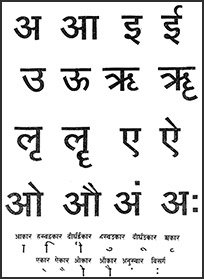Sambuddhi, Saṃbuddhi: 14 definitions
Introduction:
Sambuddhi means something in Hinduism, Sanskrit, Buddhism, Pali, Marathi, Jainism, Prakrit. If you want to know the exact meaning, history, etymology or English translation of this term then check out the descriptions on this page. Add your comment or reference to a book if you want to contribute to this summary article.
In Hinduism
Vyakarana (Sanskrit grammar)
Source: Wikisource: A dictionary of Sanskrit grammar1) Saṃbuddhi (संबुद्धि).—A term used in Panini's grammar for the case-affix of the vocative singular; cf. एकवचनं संबुद्धिः (ekavacanaṃ saṃbuddhiḥ) P. II. 3, 49; the vocative is, however, not looked upon as a separate case, but the designation संबोधन (saṃbodhana) is given to the nominative case, having the sense of संबोधनः (saṃbodhanaḥ)
2) Saṃbuddhi.—The word is also used in the general sense of संबोधन (saṃbodhana) i. e. addressing or calling; cf. एकश्रुति दूरात्संबुद्धौः किमिदं पारिभाषिक्याः संबुद्धेर्ग्रहणमेकवचनं संबुद्दिः (ekaśruti dūrātsaṃbuddhauḥ kimidaṃ pāribhāṣikyāḥ saṃbuddhergrahaṇamekavacanaṃ saṃbuddiḥ) (II. 3.49) आहोस्विदन्वर्थग्रहणं संबोधनं संबुद्दिः (āhosvidanvarthagrahaṇaṃ saṃbodhanaṃ saṃbuddiḥ) M. Bh. on P. I. 2.33.

Vyakarana (व्याकरण, vyākaraṇa) refers to Sanskrit grammar and represents one of the six additional sciences (vedanga) to be studied along with the Vedas. Vyakarana concerns itself with the rules of Sanskrit grammar and linguistic analysis in order to establish the correct context of words and sentences.
Languages of India and abroad
Pali-English dictionary
Source: Sutta: The Pali Text Society's Pali-English DictionarySambuddhi, (f.) (saṃ+buddhi) complete understanding; adj. °vant wise J. III, 361 (=buddhisampanna). (Page 693)

Pali is the language of the Tipiṭaka, which is the sacred canon of Theravāda Buddhism and contains much of the Buddha’s speech. Closeley related to Sanskrit, both languages are used interchangeably between religions.
Marathi-English dictionary
Source: DDSA: The Molesworth Marathi and English Dictionarysambuddhi (संबुद्धि).—f (S) Sameness of judgment or mind respecting. Ex. saṃ0 ghētā samāna śrīhari || śamadamavairī hari jhālā ||.
Marathi is an Indo-European language having over 70 million native speakers people in (predominantly) Maharashtra India. Marathi, like many other Indo-Aryan languages, evolved from early forms of Prakrit, which itself is a subset of Sanskrit, one of the most ancient languages of the world.
Sanskrit dictionary
Source: DDSA: The practical Sanskrit-English dictionarySaṃbuddhi (संबुद्धि).—f.
1) Perfect knowledge or perception; ततः पश्यन्त्यसंबुद्ध्या वातपित्तकफोत्तरान् (tataḥ paśyantyasaṃbuddhyā vātapittakaphottarān) Mahābhārata (Bombay) 12.216.11.
2) Full consciousness.
3) Calling to, addressing.
4) (In gram.) The vocative case; एङ् ह्रस्वात् संबुद्धेः (eṅ hrasvāt saṃbuddheḥ) P.VI.1.69.
5) An epithet.
Derivable forms: saṃbuddhiḥ (संबुद्धिः).
Source: Cologne Digital Sanskrit Dictionaries: Edgerton Buddhist Hybrid Sanskrit DictionarySaṃbuddhi (संबुद्धि).—(= Pali id.; compare prec. and next), enlighten- ment: anuttarāyāṃ (so mss.) samyaksaṃbuddhāya, or °yā, mss., Mahāvastu i.40.6; loc.; see § 10.142.
Source: Cologne Digital Sanskrit Dictionaries: Shabda-Sagara Sanskrit-English DictionarySambuddhi (सम्बुद्धि).—f.
(-ddhiḥ) 1. Calling or calling to. 2. An epithet. 3. Perfect knowledge or perception. 4. Consciousness. 5. The vocative case. E. sam with budh to know, aff. ktin .
Source: Cologne Digital Sanskrit Dictionaries: Benfey Sanskrit-English DictionarySaṃbuddhi (संबुद्धि).—i. e. sam-budh + ti, f. 1. Calling, or calling to. 2. (In grammar), The vocative case, [Pāṇini, (ed. Böhtlingk.)] 2, 3, 49.
Source: Cologne Digital Sanskrit Dictionaries: Cappeller Sanskrit-English DictionarySaṃbuddhi (संबुद्धि).—[feminine] calling to; the vocative case & its endings ([grammar]).
Source: Cologne Digital Sanskrit Dictionaries: Monier-Williams Sanskrit-English Dictionary1) Sambuddhi (सम्बुद्धि):—[=sam-buddhi] [from sam-budh] f. perfect knowledge or perception, [Monier-Williams’ Sanskrit-English Dictionary]
2) [v.s. ...] calling out to (a person in the distance), making one’s self heard, [Kātyāyana-śrauta-sūtra; Pāṇini 1-2, 33]
3) [v.s. ...] the vocative case or its termination, [Pāṇini 1-1 16 etc.]
4) [v.s. ...] an epithet, [Horace H. Wilson]
Source: Cologne Digital Sanskrit Dictionaries: Yates Sanskrit-English DictionarySambuddhi (सम्बुद्धि):—[sa-mbuddhi] (ddhiḥ) 2. f. Calling or calling to; epithet; vocative case.
Source: DDSA: Paia-sadda-mahannavo; a comprehensive Prakrit Hindi dictionary (S)Saṃbuddhi (संबुद्धि) in the Sanskrit language is related to the Prakrit word: Saṃbuddhi.
[Sanskrit to German]
Sanskrit, also spelled संस्कृतम् (saṃskṛtam), is an ancient language of India commonly seen as the grandmother of the Indo-European language family (even English!). Closely allied with Prakrit and Pali, Sanskrit is more exhaustive in both grammar and terms and has the most extensive collection of literature in the world, greatly surpassing its sister-languages Greek and Latin.
Prakrit-English dictionary
Source: DDSA: Paia-sadda-mahannavo; a comprehensive Prakrit Hindi dictionarySaṃbuddhi (संबुद्धि) in the Prakrit language is related to the Sanskrit word: Saṃbuddhi.
Prakrit is an ancient language closely associated with both Pali and Sanskrit. Jain literature is often composed in this language or sub-dialects, such as the Agamas and their commentaries which are written in Ardhamagadhi and Maharashtri Prakrit. The earliest extant texts can be dated to as early as the 4th century BCE although core portions might be older.
Kannada-English dictionary
Source: Alar: Kannada-English corpusSaṃbuddhi (ಸಂಬುದ್ಧಿ):—
1) [noun] perfect knowledge or perception.
2) [noun] (gram.) the case concerning calling out (a person at a distance).
Kannada is a Dravidian language (as opposed to the Indo-European language family) mainly spoken in the southwestern region of India.
See also (Relevant definitions)
Partial matches: Buddhi, Sha, Sam, Ca.
Ends with: Samyaksambuddhi.
Full-text: Sambodhana, Samputti, Camputti, Samyaksambuddhi, Paribhashika.
Relevant text
Search found 1 books and stories containing Sambuddhi, Saṃbuddhi, Sam-buddhi, Sa-mbuddhi; (plurals include: Sambuddhis, Saṃbuddhis, buddhis, mbuddhis). You can also click to the full overview containing English textual excerpts. Below are direct links for the most relevant articles:
Vakyapadiya of Bhartrihari (by K. A. Subramania Iyer)